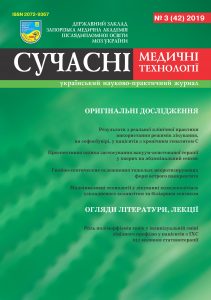Predictors of the adverse course at hospital stage of Q-myocardial infarction treatment
DOI:
https://doi.org/10.34287/MMT.3(42).2019.11Abstract
Purpose of the study. Identify predictors of the course adverse at hospital stage of Q-myocardial infarction treatment.
Materials and methods. The study involved 139 patients in the acute stage of Q-MI, average age 66 ± 0,97 year, male – 59%. Patients underwent a general clinical examination, determined the level of glycemia on admission, copeptin, NTproBNP, left ventricular ejection fraction (LVEF). 101 patients have reached cumulative endpoint (CEP), average age of 68 ± 1,02 years, of which male were 57%. As the CEP were considered one of the occurrence adverse events: death on the hospital stage (n = 17, average age 70,4 ± 2,37 years, male – 53%), development of acute heart failure (n = 94, Killip II – n = 52, Killip III n = 42, 52% were male, average age 69,2 ± 8,3 years), decreased LVEF < 45% (n = 64, average age 66 ± 1,22 years, male 63%).38 patients did not have a single endpoint, the average age 62 ± 2,2 years, male 67%.
Results. According to multivariate logistic regression analysis, independent risk factors for increased risk of intra-hospital mortality were copeptin level more than 0,87 ng/ml, which increased the odds ratio (OR) by 1,4651 times (p = 0,014) and hyperglycemia on admission more than 9,0 mmol/L, which increased intrahospital mortality by 1,2 times (p = 0,006). Independent risk factors for achieving the CEP were tachycardia (OR = 3,19; p = 0,009), increased copeptin level more than 3,3 pmol/L (OR = 1,52; p = 0,01) and hyperglycemia more than 9,3 mmol/l (OR = 1,20; p = 0,02).
Conclusion. Independent risk factors of increasing intra-hospital mortality were the level of copeptin more than 0,87ng/ml and hyperglycemia on admission more than, 9 mmol/l. Dependent and independent risk factors for CEP were tachycardia, an increase in the level of copeptin over 3,3 ng/ml and hyperglycaemia on admission more than 9,3 mmol/l.
References
Kovalenko NV, Chichkova MA, Abdulkerimova AA, Chichkova YM. Optimization of treatment of myocardial infarction with ST segment elevation against the background of chronic herpes virus infection. Sovremennyye problemy nauki i obrazovaniya. 2016; 5. http://www.science-education.ru/ru/article/ view?id=25257.
Ferreira-González I. Epidemiologia de la enfermedad coronaria. Rev Esp Cardiol. 2014 ; 67 (2): 139–144. DOI: 10.1016/j.recesp.2013.10.003.
Benjamin EJ, Virani SS, Callawey CW, Chamberlain AM et al. Heart Disease and Stroke Statistic.–2018Update:AReportFromtheAmerican Heart Association. Circulation. 2018; 137 (12): e67–e492. DOI: 10.1161/CIR.0000000000000558.
Steg PG, James SK, Atar D et al. ESC Guidelines for the management of acute myocardial infarction in patients presenting with ST-segment elevation. Task Force on the management of ST-segment elevation acute myocardial infarction of the European Society of Cardiology. Eur Heart J. 2012; 33 (20): 2569-619. DOI: 10.1093/eurheartj/ehs215.
Tseluiko VY, Mishchuk NE, Matuzok OE. Study of indicators affecting clinical forecast and heart remodeling in the late period in patients with infarction ST segment elevation myocardium. Scientific Journal «ScienceRise: Medical Science». 2017; 11 (19): 36–43. DOI: 10.15587/2519-4798.2017.116676
Moghissi ES, Korytkowski MT,DiNardoMet al. American association of clinical endocrinologists and American diabetes association consensus statement on inpatient glycemic control. Diabetes Care. 2009: 32 (6): 1119–1131. DOI.org/10.2337/ dc09-9029.
Lang RM, Badano LP, Mor-Avi V, Afilalo J et al. Recommendations for cardiac chamber quantification by echocardiography in adults: an update from the American Society of Echocardiography and the European Association of Cardiovascular Imaging. J Am Soc Echocardiogr. 2015; 28 (1):1–39. e14. DOI: 10.1016/j.echo.2014.10.003.
Dandona P, Chaudhuri A. Diabetes: Glycaemia and insulin after acute myocardial infarction. Nat Rev Endocrinol. 2014; 10 (8): 448–450. DOI: 10.1038/nrendo.2014.101.
Deckers JW, Van Domburg RT, Akkerhuis M, Nauta ST. Relation of admission glucose levels, shortand long-term (20-year) mortality after acute myocardial infarction. Am J Cardiol. 2013; 112 (9): 1306–1310. DOI: 10.1016/j.amjcard.2013.06.007.
Timmer J, Hoekstra M, Nijsten, M, van der Horst IS et al. Prognostic value of admission glycosylated hemoglobin and glucose in nondiabetic patients with ST-segment-elevation myocardial infarction treated with percutaneous coronary intervention. Circulation. 2011; 124 (6): 704–711. DOI: 10.1161/circulationaha.110.985911.
Kim EJ, Jeong MH, Kim JH, Ahn TH et al. Clinical impact of admission hyperglycemia on inhospital mortality in acute myocardial infarction patients. Int J Cardiol. 2017; 236: 9–15. DOI: 10.1016/j.ijcard.2017.01.095.
Wiviott SD, Morrow DA, Frederick PD, Antman EM et al. National Registry of Myocardial Infarction. Application of the Thrombolysis in Myocardial Infarctionriskindexinnon-ST-segment elevation myocardial infarction: evaluation of patients in the National Registry of Myocardial Infarction. J Am Coll Cardiol. 2006; 47 (8): 1553–1558. DOI: 10.1016/j.jacc.2005.11.075.
Yang HY, Ahn MJ, Jeong MH, Ahn Y, Kim YJ et al. Predictors of In-Hospital Mortality in Korean Patients with Acute Myocardial Infarction. Chonnam Med J. 2019; 55 (1): 40–46. DOI.org/10.4068/cmj.2019.55.1.40.
Schurtz G, Lamblin N, Bauters C, Goldstein P, Lemesle G . Copeptin in acute coronary syndromes and heart failure management: State of the art and future directions. Archives of Cardiovascular Diseases. 2015; 108 (6–7): 398–407. DOI: 10.1016/j.acvd.2015.04.002.
Ananth V, Beig JR, Tramboo NA et al., Does Plasma copeptin levelatadmis sionpredictfinalinfarctsizein STelevation myocardial infarction. Int. J. Cardiol. 2016; 219: 326–330.
O’Malley RG, Bonaca MP, Scirica BM, Murphy SA et al. Prognostic performance of multiple biomarkers in patients with non-ST-segment elevation acute coronary syndrome: analysis from the MERLIN-TIMI 36 trial (Metabolic Efficiency With Ranolazine for Less Ischemia in NonST-Elevation Acute Coronary SyndromesThrombolysis In Myocardial Infarction 36). J Am Coll Cardiol. 2014; 63 (16): 1644–1653. DOI: 10.1016/j.jacc.2013.12.034.
Benoit Lattuca B, Sy V, Nguyen LS, Bernard M et all. Copeptin as a prognostic biomarker in acute myocardial infarction. Int J Cardiol. 2019; 274: 337–341. DOI: 10.1016/j.ijcard.2018.09.022.
Gu YL, Voors AA, Zijlstra F, Hillege HL et al. Comparison of the temporal release pattern of copeptin with conventional biomarkers in acute myocardial infarction. Clinical Research in Cardiology. 2011; 100 (12): 1069–1076. DOI: 10.1007/s00392-011-0343-y.
Kelly D, Squire IB, Khan SQ, Quinn P et al. C-terminal provasopressin (copeptin) is associated with left ventricular dysfunction, remodeling, and clinical heart failure in survivors of myocardial infarction. J Card Fail. 2008; 14 (9): 739–745. DOI: 10.1016/j.cardfail.2008.07.231.
Syvolap VD, Kapshytar NI. Predictors of development of acute heart failure in patients with acute period ofmyocardial Q-infarction. Zaporizkyy medychnyy zhurnal. 2019; 2 (113): 160–164 DOI:10.14739/2310-1210.2019.2.161319.
Voors AA, von Haehling S, Anker SD, Hillege HL, et al. C-terminal provasopressin (copeptin) is a strong prognostic marker in patients with heart failure after anacute myocardial infarction: results fromthe OPTIMAAL study. Eur Heart J. 2009; 30: 1187–1194. DOI: 10.1093/eurheartj/ehp098.
Kremneva LV. The value of co-peptin for the diagnosis of myocardial infarction. Rossiyskiy kardiologicheskiy zhurnal. 2017; 151 (11): 93–97. http://dx.doi.org/10.15829/1560-4071-2017-11-93-9.
Khan SQ, Dhillon OS, O’Brien R.J, Struck J et al. C-terminal provasopressin (copeptin) as a novel and prognostic marker in acute myocardial infarction: Leicester Acute Myocardial Infarction Peptide (LAMP) study. Circulation. 2007; 115 (16): 2103–2110. DOI: 10.1161/circulationaha.106.685503.
Downloads
Published
How to Cite
Issue
Section
License
The work is provided under the terms of the Public Offer and of Creative Commons Attribution-NonCommercial 4.0 International (CC BY-NC 4.0). This license allows an unlimited number of persons to reproduce and share the Licensed Material in all media and formats. Any use of the Licensed Material shall contain an identification of its Creator(s) and must be for non-commercial purposes only.














